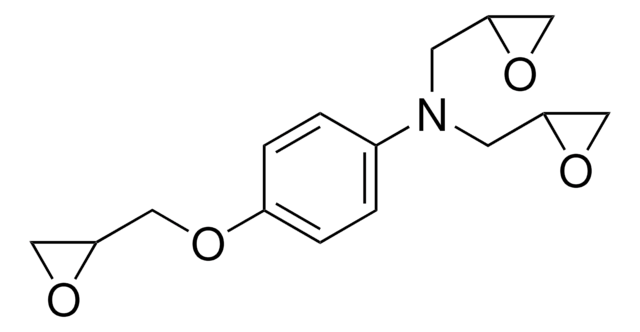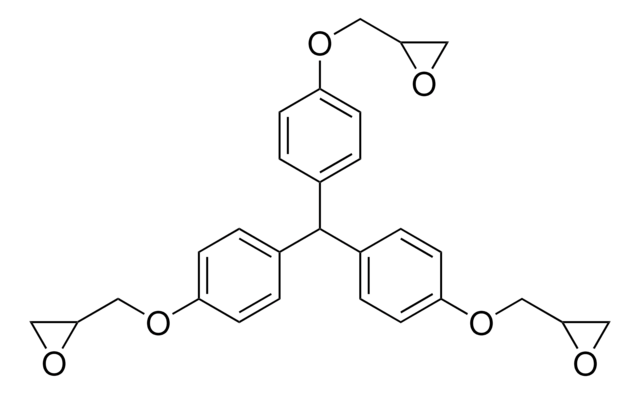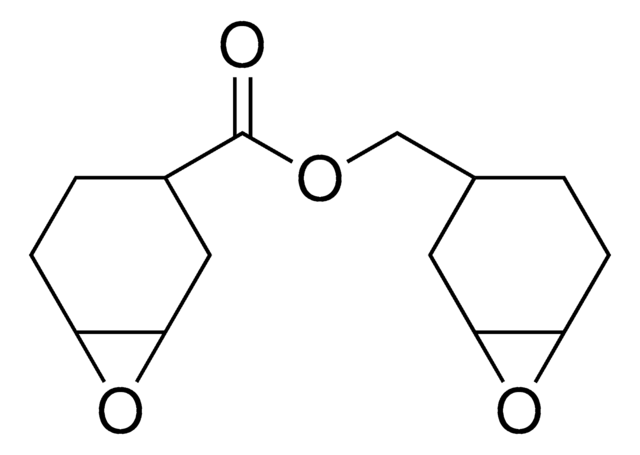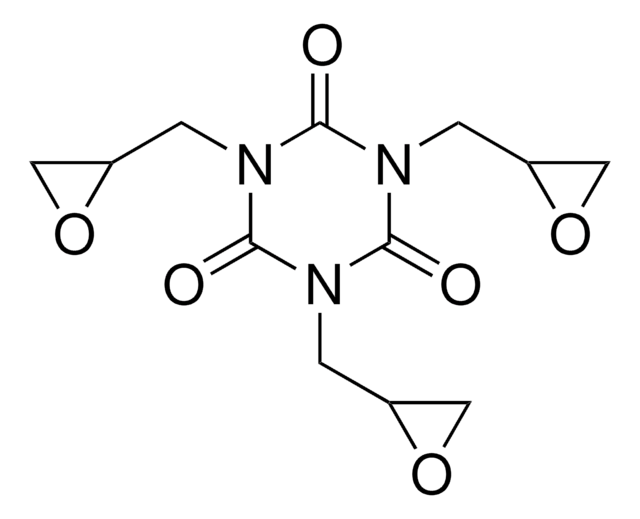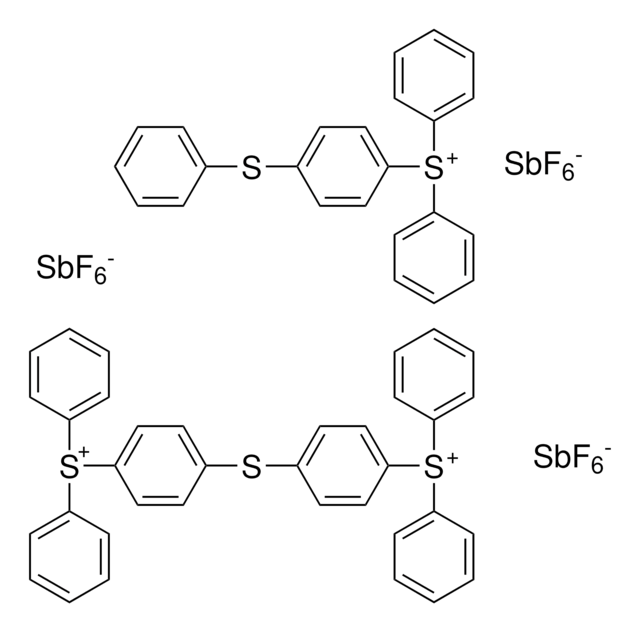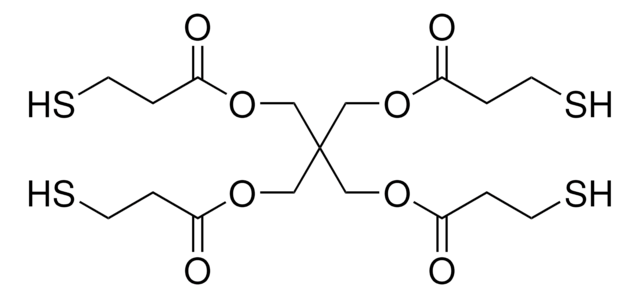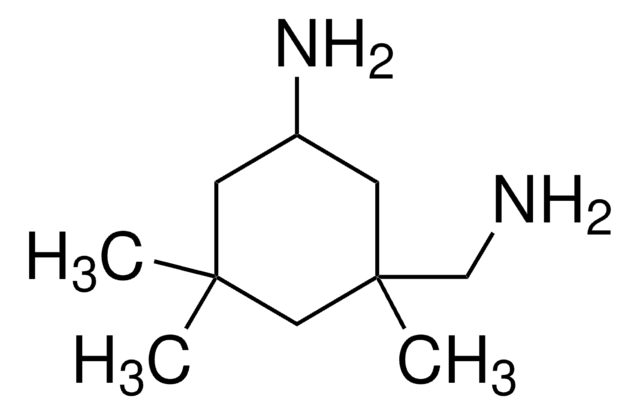412805
4,4′-亚甲基二(N,N-二缩水甘油基苯胺)
别名:
4,4′-亚甲基二苯胺四缩水甘油醚, 4,4′-亚甲基双[N ,N -双(环氧乙基甲基)苯胺], N ,N ,N ′,N ′-四缩水甘油基-4,4′-亚甲基二苯胺, N ,N ,N ′,N ′-四缩水甘油基-4,4′-亚甲基双苯胺, 双[4-(二环氧胺)苯基]甲烷
登录查看公司和协议定价
选择尺寸
所有图片(1)
选择尺寸
变更视图
About This Item
经验公式(希尔记法):
C25H30N2O4
CAS号:
分子量:
422.52
EC 号:
MDL编号:
UNSPSC代码:
12162002
PubChem化学物质编号:
NACRES:
NA.23
推荐产品
表单
viscous liquid
质量水平
折射率
n20/D 1.601 (lit.)
密度
1.15 g/mL at 25 °C (lit.)
SMILES字符串
C1OC1CN(CC2CO2)c3ccc(Cc4ccc(cc4)N(CC5CO5)CC6CO6)cc3
InChI
1S/C25H30N2O4/c1-5-20(26(10-22-14-28-22)11-23-15-29-23)6-2-18(1)9-19-3-7-21(8-4-19)27(12-24-16-30-24)13-25-17-31-25/h1-8,22-25H,9-17H2
InChI key
FAUAZXVRLVIARB-UHFFFAOYSA-N
一般描述
4,4′-亚甲基双(N,N-二缩水甘油基苯胺)(MDGA)是一种具有两个环氧基(缩水甘油基)和两个胺基的双官能单体。它通常用作生产热固性聚合物,特别是环氧树脂的单体。基于MDGA的环氧树脂可以表现出所需的性能,例如高强度、耐化学性和热稳定性,这使它们适用于广泛的应用,例如粘合剂、涂层、复合材料和电子封装。
应用
4,4′-亚甲基双(N,N-二缩水甘油基苯胺)可用于:
- 作为合成紫外线可固化四官能环氧丙烯酸酯(EA4)的原料,它被用作紫外光固化树脂的交联剂。
- 在双马来酰亚胺/二烯丙基双酚A(BMI/DBA)–环氧互穿网络树脂的合成中,由于其高热稳定性和低活化能,在航空航天和汽车工业中具有潜在的应用。
- 作为生物相容性材料(例如,水凝胶和其他组织工程支架)生产中的交联剂。它形成强大而稳定的交联的能力使其在医疗器械、植入物和药物输送系统的制造中具有价值。此外,它还用于合成生物相容性聚合物和具有定制性能的材料,用于生物医学应用。
- 聚(六亚甲基双胍)基聚合物网络,可作为植物油酯交换反应的催化剂。
- 四官能环氧丙烯酸酯紫外线固化树脂。
警示用语:
Warning
危险声明
危险分类
Aquatic Chronic 2 - Muta. 2 - Skin Sens. 1
储存分类代码
10 - Combustible liquids
WGK
WGK 2
个人防护装备
Eyeshields, Faceshields, Gloves, type ABEK (EN14387) respirator filter
L Kanerva et al.
Dermatology (Basel, Switzerland), 201(1), 29-33 (2000-09-06)
Very little is known about allergic contact dermatitis (ACD) from preimpregnated epoxy products (prepregs). To describe a patient with occupational ACD from prepregs, and report new quantitative data on the content of prepregs. A laminator developed work-related vesicular hand dermatitis.
D Burrows et al.
Contact dermatitis, 11(2), 80-82 (1984-08-01)
An outbreak of dermatitis occurred in an aircraft factory using epoxy resin composite material. Of 25 operatives, 14 gave positive patch test reactions to the composite material and/or diglycidylether of bisphenol A (DGEBA), tetraglycidyl-4,4'-methylene dianiline (TGMDA), and o-diglycidyl phthalate. This
F Ayala et al.
Contact dermatitis, 22(5), 262-266 (1990-05-01)
Thin-layer chromatography, column chromatography, mass spectrometry and nuclear magnetic resonance were used to investigate the chemical constituents and haptens responsible in 2 different circumstances where allergic contact dermatitis from composite materials was suspected. In an aircraft factory where epoxy resins
Michael Giebler et al.
Polymers, 12(5) (2020-05-21)
Epoxy-anhydride vitrimers are covalent adaptable networks, which undergo associative bond exchange reactions at elevated temperature. Their service temperature is influenced by the glass transition temperature (Tg) as well as the topology freezing transition temperature (Tv), at which the covalent bond
我们的科学家团队拥有各种研究领域经验,包括生命科学、材料科学、化学合成、色谱、分析及许多其他领域.
联系客户支持